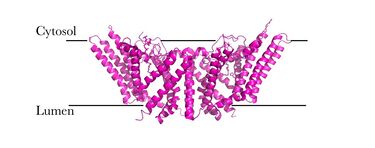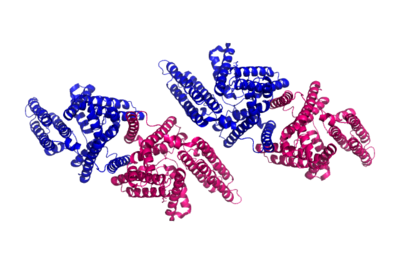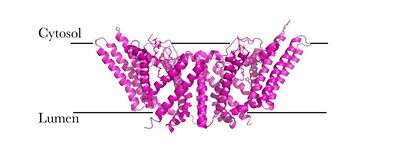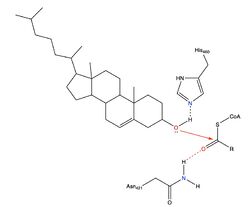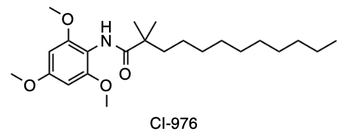User:Madison Unger/Sandbox 1
From Proteopedia
(Difference between revisions)
| Line 2: | Line 2: | ||
<StructureSection load='6l47' size='340' frame='true' side='right' caption='Functioning dimer of ACAT' scene='87/877507/Dimer/5'> | <StructureSection load='6l47' size='340' frame='true' side='right' caption='Functioning dimer of ACAT' scene='87/877507/Dimer/5'> | ||
== Introduction == | == Introduction == | ||
| - | [[Image:Newmechbigwords.png|500px|right|thumb|Figure 1: Function of ACAT]] Acyl-coenzyme A: cholesterol acyltransferase <scene name='87/877507/Dimer/5'>(ACAT)</scene>, also known as Human Sterol O-acyltransferase (hSOAT) is an enzyme that catalyzes the reaction between long chain [http://en.wikipedia.org/wiki/Long-chain-fatty-acid%E2%80%94CoA_ligase fatty acyl CoA] and intracellular [http://en.wikipedia.org/wiki/Cholesterol cholesterol] to form the more hydrophobic cholesteryl ester for cholesterol storage (Fig.1). [http://en.wikipedia.org/wiki/Cholesteryl_ester Cholesteryl ester] is the primary form of how cholesterol is stored in multiple types of cells and transported through the circulatory system. ACAT is an endoplasmic reticulum membrane protein, and ACAT is a part of the [http://en.wikipedia.org/wiki/MBOAT MBOAT] (membrane-bound O-acyltransferase) family, which also includes acyl-coenzyme A: <scene name='87/877507/Dgat/2'>diacylglycerol acyltransferase</scene> ([http://en.wikipedia.org/wiki/Diglyceride_acyltransferase DGAT]) and <scene name='87/877506/Goat/1'>ghrelin O-acyltransferase</scene> ([http://en.wikipedia.org/wiki/Ghrelin_O-acyltransferase GOAT]).<ref>PMID:32433610</ref> <ref>PMID:19356147</ref> | + | [[Image:Newmechbigwords.png|500px|right|thumb|Figure 1: Function of ACAT]] Acyl-coenzyme A: cholesterol acyltransferase <scene name='87/877507/Dimer/5'>(ACAT)</scene>, also known as Human Sterol O-acyltransferase (hSOAT) is an enzyme that catalyzes the reaction between long chain [http://en.wikipedia.org/wiki/Long-chain-fatty-acid%E2%80%94CoA_ligase fatty acyl CoA] and intracellular [http://en.wikipedia.org/wiki/Cholesterol cholesterol] to form the more hydrophobic cholesteryl ester for cholesterol storage (Fig.1). [http://en.wikipedia.org/wiki/Cholesteryl_ester Cholesteryl ester] is the primary form of how cholesterol is stored in multiple types of cells and transported through the circulatory system. ACAT is an endoplasmic reticulum membrane protein, and ACAT is a part of the [http://en.wikipedia.org/wiki/MBOAT MBOAT] (membrane-bound O-acyltransferase) family, which also includes acyl-coenzyme A: <scene name='87/877507/Dgat/2'>diacylglycerol acyltransferase</scene> ([http://en.wikipedia.org/wiki/Diglyceride_acyltransferase DGAT]) and <scene name='87/877506/Goat/1'>ghrelin O-acyltransferase</scene> ([http://en.wikipedia.org/wiki/Ghrelin_O-acyltransferase GOAT]).<ref>PMID:32433610</ref> <ref>PMID:19356147</ref> [[Image:Cytosol lumen pic.jpg|375px|right|thumb|Figure 2: Orientation showing the cytosolic and lumen sides of the dimer]] |
There have been two ACAT [http://en.wikipedia.org/wiki/Protein_isoform isoforms] discovered in mammals, ACAT1<ref name="Qian">PMID:32433614</ref> and ACAT2<ref name="Cases">PMID:9756919</ref>, and they are predominantly located in different parts of the body. ACAT1 is mainly found in the liver, kidneys, adrenal glands and macrophages, whereas ACAT2 is found only in the intestines and liver. | There have been two ACAT [http://en.wikipedia.org/wiki/Protein_isoform isoforms] discovered in mammals, ACAT1<ref name="Qian">PMID:32433614</ref> and ACAT2<ref name="Cases">PMID:9756919</ref>, and they are predominantly located in different parts of the body. ACAT1 is mainly found in the liver, kidneys, adrenal glands and macrophages, whereas ACAT2 is found only in the intestines and liver. | ||
| Line 8: | Line 8: | ||
== Structure == | == Structure == | ||
=== Overall Structure === | === Overall Structure === | ||
| - | ACAT is a tetramer composed of a [http://en.wikipedia.org/wiki/Protein_dimer dimer] of a dimer, but is able to perform its function solely as a dimer (Fig. | + | ACAT is a tetramer composed of a [http://en.wikipedia.org/wiki/Protein_dimer dimer] of a dimer, but is able to perform its function solely as a dimer (Fig. 3). [[Image:Tetramer_dimer_of_dimer.png|400px|left|thumb|Figure 3: Tetrameric dimer of dimer for ACAT]]There are <scene name='87/877508/9_transmembrane_helices/1'>nine transmembrane helices</scene> in each domain which create a tunnel for the active site. There are also three helices found on the intracellular side (IH1, IH2, and IH3) and one helix on the extracellular side (EH1). The active site contains three tunnels – the transmembrane tunnel for cholesterol entrance, the cytosolic tunnel for acyl-CoA entrance, and the lumen tunnel for cholesterol ester exit. ACAT also has an amino-terminal cytosolic domain (NTD) that is important for tetramerization of this protein.<ref name= "Cases" /> |
=== Dimer-Dimer Interactions === | === Dimer-Dimer Interactions === | ||
The two dimers make limited contact within the membrane through an interface that has <scene name='87/877508/Dimer_interface/1'>hydrophobic residues</scene> in between the two protomers <ref name="Qian" />. Between the two protomers in each dimer, Van der Waals interactions occur between TM1 of one [http://en.wikipedia.org/wiki/Protomer protomer] and the lumenal TM6 and the cytosolic TM9 of the other protomer. | The two dimers make limited contact within the membrane through an interface that has <scene name='87/877508/Dimer_interface/1'>hydrophobic residues</scene> in between the two protomers <ref name="Qian" />. Between the two protomers in each dimer, Van der Waals interactions occur between TM1 of one [http://en.wikipedia.org/wiki/Protomer protomer] and the lumenal TM6 and the cytosolic TM9 of the other protomer. | ||
| Line 19: | Line 19: | ||
== Proposed Mechanism == | == Proposed Mechanism == | ||
| - | Due to limited high-resolution structural representations of ACAT, its mechanism remains ambiguous. [[Image:Thenewacatmech2.jpg|250px|left|thumb|Figure | + | Due to limited high-resolution structural representations of ACAT, its mechanism remains ambiguous. [[Image:Thenewacatmech2.jpg|250px|left|thumb|Figure 5: Mechanism for ACAT proposed by Qian et al.]] However, the general mechanism involving the substrates and products of ACAT is understood<ref name="Guan">PMID:32424158</ref>. In this reaction, [http://en.wikipedia.org/wiki/Stearoyl-CoA_9-desaturase oleoyl-CoA] and cholesterol are the reactants and they undergo the reaction catalyzed by ACAT to form cholesteryl-oleate which is used as a storage form of cholesterol. The hydroxyl group on cholesterol is deprotonated, then attacks the [http://en.wikipedia.org/wiki/Thioester thioester] bond of oleoyl-CoA, kicking off CoA-SH as a leaving group. |
| - | However, Qian et al.<ref name="Qian" /> proposed a mechanism involving the important residues His460 and Asn421. In this mechanism, His460 acts as a general base to deprotonate the hydroxyl group on cholesterol, activating it as a [http://en.wikipedia.org/wiki/Nucleophile nucleophile]. Then, Asn421 possibly forms a hydrogen bond with oleoyl-CoA to stabilize the reaction (Fig. | + | However, Qian et al.<ref name="Qian" /> proposed a mechanism involving the important residues His460 and Asn421. In this mechanism, His460 acts as a general base to deprotonate the hydroxyl group on cholesterol, activating it as a [http://en.wikipedia.org/wiki/Nucleophile nucleophile]. Then, Asn421 possibly forms a hydrogen bond with oleoyl-CoA to stabilize the reaction (Fig. 5). |
| Line 29: | Line 29: | ||
== Known Inhibitors == | == Known Inhibitors == | ||
| - | Guan et al. has identified a small molecule inhibitor of ACAT, known as CI-976, which belongs to the fatty acyl amide analog molecule family. <scene name='87/877508/Ci-976_inhibitor/2'>CI-976</scene> is a competitive inhibitor in the ACAT active site and was found to inhibit ACAT in a dose-dependent manner (Fig. | + | Guan et al. has identified a small molecule inhibitor of ACAT, known as CI-976, which belongs to the fatty acyl amide analog molecule family. <scene name='87/877508/Ci-976_inhibitor/2'>CI-976</scene> is a competitive inhibitor in the ACAT active site and was found to inhibit ACAT in a dose-dependent manner (Fig. 6). CI-976 has a trimethoxyphenol head that interacts with the catalytic residue, His460. This head also interacts with Tyr416 and Tyr417. The long-chain tail of CI-476 also interacts with specific residues, notably Leu377 and Leu515. [[Image:Inhibitor structureCI9.png|350px|left|thumb|Figure 6: Structure of known ACAT inhibitor]]Overall, it was determined that because CI-976 binds in the active site, it inhibits ACAT by preventing the binding of the natural substrate into the active site<ref name="Guan" />. |
== Medical Relevance == | == Medical Relevance == | ||
The mechanism of ACAT is essential for cholesterol storage and cholesterol transfer through the plasma because cholesteryl ester is the primary form of cholesterol used for these events. Additionally, ACAT can use a variety of different sterol molecules besides cholesterol as substrates and activators. Because of its biological importance, ACAT has been linked to [http://en.wikipedia.org/wiki/Atherosclerosis atherosclerosis], [http://en.wikipedia.org/wiki/Alzheimer%27s_disease Alzheimer’s disease], and cancer as a potential drug target for treatment of these diseases<ref>PMID:17986151</ref>. Various studies have looked into ACAT inhibition and how that inhibition treats or prevents certain diseases, such as reducing the size and metastasis of certain tumors<ref>PMID:27132508</ref> and reducing the formation of plaques in atherosclerosis<ref>PMID:11100106</ref>. ACAT is an important target for these diseases due to its functional relevance in cholesterol metabolism. | The mechanism of ACAT is essential for cholesterol storage and cholesterol transfer through the plasma because cholesteryl ester is the primary form of cholesterol used for these events. Additionally, ACAT can use a variety of different sterol molecules besides cholesterol as substrates and activators. Because of its biological importance, ACAT has been linked to [http://en.wikipedia.org/wiki/Atherosclerosis atherosclerosis], [http://en.wikipedia.org/wiki/Alzheimer%27s_disease Alzheimer’s disease], and cancer as a potential drug target for treatment of these diseases<ref>PMID:17986151</ref>. Various studies have looked into ACAT inhibition and how that inhibition treats or prevents certain diseases, such as reducing the size and metastasis of certain tumors<ref>PMID:27132508</ref> and reducing the formation of plaques in atherosclerosis<ref>PMID:11100106</ref>. ACAT is an important target for these diseases due to its functional relevance in cholesterol metabolism. | ||
Revision as of 19:41, 19 April 2021
Human Acyl-Coenzyme A
| |||||||||||
References
- ↑ Wang L, Qian H, Nian Y, Han Y, Ren Z, Zhang H, Hu L, Prasad BVV, Laganowsky A, Yan N, Zhou M. Structure and mechanism of human diacylglycerol O-acyltransferase 1. Nature. 2020 May;581(7808):329-332. doi: 10.1038/s41586-020-2280-2. Epub 2020 May, 13. PMID:32433610 doi:http://dx.doi.org/10.1038/s41586-020-2280-2
- ↑ Moorthy PS, Neelagandan K, Balasubramanian M, Ponnuswamy MN. Purification, Crystallization and Preliminary X-Ray Diffraction Studies on Goat (Capra hircus) Hemoglobin - A Low Oxygen Affinity Species. Protein Pept Lett. 2009;16(4):454-6. PMID:19356147
- ↑ 3.0 3.1 3.2 3.3 3.4 Qian H, Zhao X, Yan R, Yao X, Gao S, Sun X, Du X, Yang H, Wong CCL, Yan N. Structural basis for catalysis and substrate specificity of human ACAT1. Nature. 2020 May;581(7808):333-338. doi: 10.1038/s41586-020-2290-0. Epub 2020 May, 13. PMID:32433614 doi:http://dx.doi.org/10.1038/s41586-020-2290-0
- ↑ 4.0 4.1 Cases S, Novak S, Zheng YW, Myers HM, Lear SR, Sande E, Welch CB, Lusis AJ, Spencer TA, Krause BR, Erickson SK, Farese RV Jr. ACAT-2, a second mammalian acyl-CoA:cholesterol acyltransferase. Its cloning, expression, and characterization. J Biol Chem. 1998 Oct 9;273(41):26755-64. doi: 10.1074/jbc.273.41.26755. PMID:9756919 doi:http://dx.doi.org/10.1074/jbc.273.41.26755
- ↑ 5.0 5.1 Guan C, Niu Y, Chen SC, Kang Y, Wu JX, Nishi K, Chang CCY, Chang TY, Luo T, Chen L. Structural insights into the inhibition mechanism of human sterol O-acyltransferase 1 by a competitive inhibitor. Nat Commun. 2020 May 18;11(1):2478. doi: 10.1038/s41467-020-16288-4. PMID:32424158 doi:http://dx.doi.org/10.1038/s41467-020-16288-4
- ↑ Liu J, Chang CC, Westover EJ, Covey DF, Chang TY. Investigating the allosterism of acyl-CoA:cholesterol acyltransferase (ACAT) by using various sterols: in vitro and intact cell studies. Biochem J. 2005 Oct 15;391(Pt 2):389-97. doi: 10.1042/BJ20050428. PMID:15992359 doi:http://dx.doi.org/10.1042/BJ20050428
- ↑ Rogers MA, Liu J, Song BL, Li BL, Chang CC, Chang TY. Acyl-CoA:cholesterol acyltransferases (ACATs/SOATs): Enzymes with multiple sterols as substrates and as activators. J Steroid Biochem Mol Biol. 2015 Jul;151:102-7. doi: 10.1016/j.jsbmb.2014.09.008., Epub 2014 Sep 12. PMID:25218443 doi:http://dx.doi.org/10.1016/j.jsbmb.2014.09.008
- ↑ Hartmann T, Kuchenbecker J, Grimm MO. Alzheimer's disease: the lipid connection. J Neurochem. 2007 Nov;103 Suppl 1:159-70. doi: 10.1111/j.1471-4159.2007.04715.x. PMID:17986151 doi:http://dx.doi.org/10.1111/j.1471-4159.2007.04715.x
- ↑ Li J, Gu D, Lee SS, Song B, Bandyopadhyay S, Chen S, Konieczny SF, Ratliff TL, Liu X, Xie J, Cheng JX. Abrogating cholesterol esterification suppresses growth and metastasis of pancreatic cancer. Oncogene. 2016 Dec 15;35(50):6378-6388. doi: 10.1038/onc.2016.168. Epub 2016 May , 2. PMID:27132508 doi:http://dx.doi.org/10.1038/onc.2016.168
- ↑ Rudel LL, Shelness GS. Cholesterol esters and atherosclerosis-a game of ACAT and mouse. Nat Med. 2000 Dec;6(12):1313-4. doi: 10.1038/82110. PMID:11100106 doi:http://dx.doi.org/10.1038/82110
Student Contributors
- Leah Goehring
- Gabby Smith
- Anna Campbell

